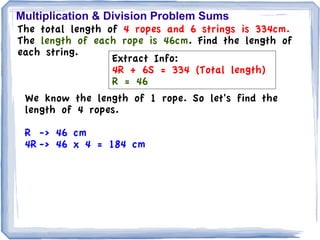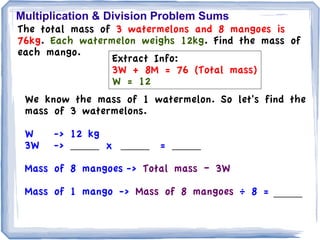P4 Multiplication & Division Problem Sums
- 1. Primary 4 Multiplication and Division Word Problems
- 2. Multiplication & Division Problem Sums There were 4 times as many children as adults in a party. After 16 adults left, the number of children in the party was 20 times the number of the remaining adults. How many people attended the party?
- 3. Multiplication & Division Problem Sums There were 4 times as many children as adults in a party. After 16 adults left, the number of children in the party was 20 times the number of the remaining adults. How many people attended the party? Extract Info: C -> 4u Draw the models A -> 1u according to your extracted info. Notice the number of children remains unchanged. Therefore, we multiply 4u by 5 to get 20u for the children. Logically, we also multiply 1u by 5 for the adults. C -> 20u ? A -> 5u - 16
- 4. Multiplication & Division Problem Sums There were 4 times as many children as adults in a party. After 16 adults left, the number of children in the party was 20 times the number of the remaining adults. How many people attended the party? Extracted Info C -> 20u A -> 5u - 16 C ? A 16
- 5. Multiplication & Division Problem Sums There were 4 times as many children as adults in a party. After 16 adults left, the number of children in the party was 20 times the number of the remaining adults. How many people attended the party? Extracted Info C -> 20u A -> 5u - 16 C ? A 16 4u -> 16 1u -> 16 ├Ę 4 = 4
- 6. Multiplication & Division Problem Sums There were 4 times as many children as adults in a party. After 16 adults left, the number of children in the party was 20 times the number of the remaining adults. How many people attended the party? Extracted Info C -> 20u A -> 5u - 16 C ? A 16 4u -> 16 1u -> 16 ├Ę 4 = 4 25u -> 25 x 4 = 100 100 people attended the party.
- 7. Multiplication & Division Problem Sums Mark went shopping with twice as much money as Paul. After Paul spent $60, Mark had 6 times as much money as Paul. How much more money did Mark bring along for shopping than Paul?
- 8. Multiplication & Division Problem Sums Mark went shopping with twice as much money as Paul. After Paul spent $60, Mark had 6 times as much money as Paul. How much more money did Mark bring along for shopping than Paul? Extract Info: Mark -> 2u Draw the models Paul -> 1u according to your extracted info. Notice Mark's money remains unchanged. Therefore, we multiply 2u by 3 to get 6u for Mark. Logically, we also multiply 1u by 3 for Paul. Mark -> (2u x 3) = 6u Paul -> (1u x 3) = 3u - 60
- 9. Multiplication & Division Problem Sums Mark went shopping with twice as much money as Paul. After Paul spent $60, Mark had 6 times as much money as Paul. How much more money did Mark bring along for shopping than Paul? Extract Info: Mark -> (2u x 3) = 6u Paul -> (1u x 3) = 3u - 60 Mark ? Paul 60
- 10. Multiplication & Division Problem Sums Mark went shopping with twice as much money as Paul. After Paul spent $60, Mark had 6 times as much money as Paul. How much more money did Mark bring along for shopping than Paul? Extract Info: Mark -> (2u x 3) = 6u Paul -> (1u x 3) = 3u - 60 Mark 2u -> 60 ? Paul 60
- 11. Multiplication & Division Problem Sums Mark went shopping with twice as much money as Paul. After Paul spent $60, Mark had 6 times as much money as Paul. How much more money did Mark bring along for shopping than Paul? Extract Info: Mark -> (2u x 3) = 6u Paul -> (1u x 3) = 3u - 60 Mark 2u -> 60 1u -> 60 ├Ę 2 = 30 ? Paul 60
- 12. Multiplication & Division Problem Sums Mark went shopping with twice as much money as Paul. After Paul spent $60, Mark had 6 times as much money as Paul. How much more money did Mark bring along for shopping than Paul? Extract Info: Mark -> (2u x 3) = 6u Paul -> (1u x 3) = 3u - 60 Mark 2u -> 60 1u -> 60 ├Ę 2 = 30 ? 3u -> 30 x 3 = 90 Paul 60 Mark brought $90 more than Paul.
- 13. Multiplication & Division Problem Sums The total cost of 3 erasers and 5 pens is $52. Each pen costs $8. Find the cost of each eraser. Extract Info: 3E + 5P = 52 (Total cost) P = 8 We know the cost of 1 pen. So let's find the cost of 5 pens.
- 14. Multiplication & Division Problem Sums The total cost of 3 erasers and 5 pens is $52. Each pen costs $8. Find the cost of each eraser. Extract Info: 3E + 5P = 52 (Total cost) P = 8 P -> $8 5P -> 5 x $8 = $40
- 15. Multiplication & Division Problem Sums The total cost of 3 erasers and 5 pens is $52. Each pen costs $8. Find the cost of each eraser. Extract Info: 3E + 5P = 52 (Total cost) P = 8 P -> $8 5P -> 5 x $8 = $40 Cost of 3 erasers -> Total cost ŌĆō Cost of 5 pens -> $52 ŌĆō $40 -> $12
- 16. Multiplication & Division Problem Sums The total cost of 3 erasers and 5 pens is $52. Each pen costs $8. Find the cost of each eraser. Extract Info: 3E + 5P = 52 (Total cost) P = 8 P -> $8 5P -> 5 x $8 = $40 Cost of 3 erasers -> Total cost ŌĆō Cost of 5 pens -> $52 ŌĆō $40 -> $12 Cost of 1 eraser -> $12 ├Ę 3 = $4
- 17. Multiplication & Division Problem Sums The total length of 4 ropes and 6 strings is 334cm. The length of each rope is 46cm. Find the length of each string. Extract Info: 4R + 6S = 334 (Total length) R = 46 We know the length of 1 rope. So let's find the length of 4 ropes.
- 18. Multiplication & Division Problem Sums The total length of 4 ropes and 6 strings is 334cm. The length of each rope is 46cm. Find the length of each string. Extract Info: 4R + 6S = 334 (Total length) R = 46 We know the length of 1 rope. So let's find the length of 4 ropes. R -> 46 cm 4R -> 46 x 4 = 184 cm
- 19. Multiplication & Division Problem Sums The total length of 4 ropes and 6 strings is 334cm. The length of each rope is 46cm. Find the length of each string. Extract Info: 4R + 6S = 334 (Total length) R = 46 We know the length of 1 rope. So let's find the length of 4 ropes. R -> 46 cm 4R -> 46 x 4 = 184 cm Length of 6 strings -> Total length ŌĆō 4R -> 334 ŌĆō 184 -> 150 cm
- 20. Multiplication & Division Problem Sums The total length of 4 ropes and 6 strings is 334cm. The length of each rope is 46cm. Find the length of each string. Extract Info: 4R + 6S = 334 (Total length) R = 46 We know the length of 1 rope. So let's find the length of 4 ropes. R -> 46 cm 4R -> 46 x 4 = 184 cm Length of 6 strings -> Total length ŌĆō 4R -> 334 ŌĆō 184 -> 150 cm Length of 1 string -> 150 ├Ę 6 = 25 cm
- 21. Multiplication & Division Problem Sums The total mass of 3 watermelons and 8 mangoes is 76kg. Each watermelon weighs 12kg. Find the mass of each mango. Extract Info: 3W + 8M = 76 (Total mass) W = 12 We know the mass of 1 watermelon. So let's find the mass of 3 watermelons.
- 22. Multiplication & Division Problem Sums The total mass of 3 watermelons and 8 mangoes is 76kg. Each watermelon weighs 12kg. Find the mass of each mango. Extract Info: 3W + 8M = 76 (Total mass) W = 12 We know the mass of 1 watermelon. So let's find the mass of 3 watermelons. W -> 12 kg 3W -> x = Mass of 8 mangoes -> Total mass ŌĆō 3W Mass of 1 mango -> Mass of 8 mangoes ├Ę 8 =






















